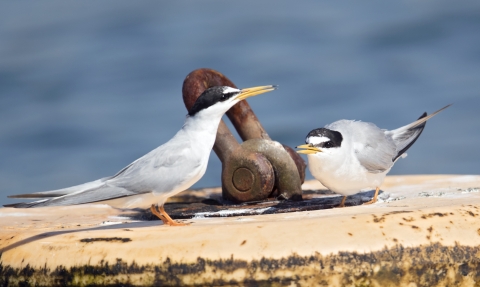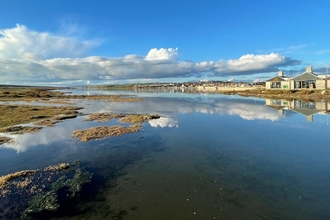
Little Terns at Chesil Beach © Paul Williams
Little terns at Chesil Beach
Little Terns at Chesil Beach
There are fewer than 2,000 breeding pairs of little terns (Sternula albifrons) in the UK, making them one of the rarest nesting seabirds in the country. Chesil Beach is an important nesting site for this endangered species, as it is the only colony in the southwest of England, having approximately 40 to 50 pairs returning to breed each year.
These charismatic birds can be seen from mid-April to the end of August, and one of the best ways to view them is by taking a boat trip on board the Fleet Explorer in the summer months when there are often special tern watching trips running as well.
About Little Terns
Weighing in at around 57g – a similar size to a tennis ball – the little tern is the UK’s smallest species of tern, characterised by a black cap, white forehead and a bright yellow bill. Little terns feed on fish, small crustaceans and invertebrates and with the Fleet Lagoon, Portland Harbour and Lyme Bay a stone’s throw from the colony at Chesil Beach, the area provides plenty of feeding opportunities for these birds.
Little terns are a migratory species and will spend the colder months overwintering along the coast of West Africa before travelling over 3,000 miles to reach their breeding grounds in the UK. Little terns usually live for around 12 years, but the oldest recorded individual was 25 years old, meaning it travelled over 150,000 miles in its lifetime! The little tern comes to Chesil Beach to breed. After arriving in the middle of April adults will perform acrobatic aerial displays during the courtship process, with males carrying small fish and calling to attract a mate. The females will fly up to the males and once the male lands will follow him and accept the fish if they are interested. The females will then lay two to three eggs in a small scrape amongst the pebbles, which are very well camouflaged, and will hatch after 18 to 22 days of incubation.
Little terns are vulnerable to many different threats throughout the season, including predation by species such as foxes, hedgehogs (which eat the eggs) and birds of prey, for example kestrels. They are also susceptible during the breeding season to human-based disturbance, with adults being easily flushed from the nests leaving their eggs/chicks exposed to the weather and predators.
The population of little terns has been in decline since the 1960s/1970s, and as a result are legally protected under the Wildlife and Countryside Act 1981 They are given the highest level of protection, being classified as a Schedule 1 species, making it illegal to intentionally or recklessly disturb them whilst they are building a nest, when adults are in, on, or near a nest containing eggs or young and disturbing dependent young of the little tern.
Little Terns on Chesil Beach video (https://www.youtube.com/watch?time_continue=54&v=NcmzbImd-aM)
Little Terns on Chesil Beach video
Chesil Beach Little Tern Project
Little terns have been nesting along Chesil Beach, alongside common terns for many years and in 1984 they were first recorded nesting at Ferrybridge. By the 1990s, this was their sole nesting site along Chesil Beach. The Ilchester Estates appointed a warden to manage the colony for many years who monitored and protected the nesting birds
In 2009, RSPB took over management of the Chesil Little Tern Recovery Project in partnership with Dorset Wildlife Trust, Chesil and Fleet Nature Reserve, Portland Court Leet, Crown Estate, Dorset Council and Natural England.
Throughout the season, between April and the end of August, the RSPB team monitors the colony and records key pieces of information, from the number of breeding pairs and fledglings, to recording human disturbance.
Fence barriers for the little tern colony on Chesil Beach © DWT
Volunteering
Volunteers are essential for this project to succeed. If you would like to volunteer, please apply here or get in touch with chesil.tern@rspb.org.uk.






